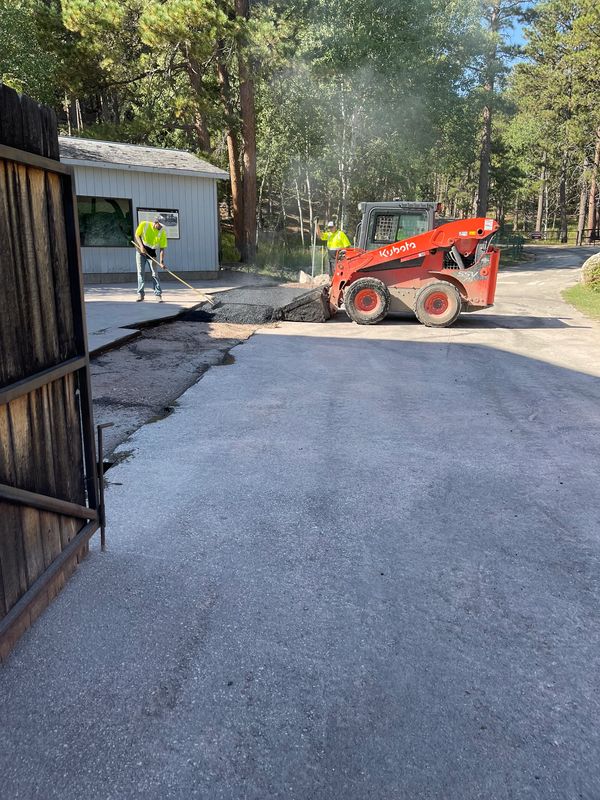Understanding Tilted Parking: How Asphalt Sealing Boosts Commercial Lots
Wiki Article
Warm Mix Asphalt: A Sustainable Option for Sidewalk
Hot Mix Asphalt (HMA) has emerged as a leading sustainable selection for sidewalk solutions, supplying a myriad of ecological benefits and cutting-edge innovations. As the demand for eco-friendly building and construction practices grows, exploring the subtleties of HMA's sustainability can supply valuable understandings into the future of pavement remedies.Environmental Advantages of Hot Mix Asphalt

Additionally, Warm Mix Asphalt assists to mitigate metropolitan heat island impacts. Its dark shade soaks up sunshine, reducing the quantity of warmth showed back into the ambience compared to lighter-colored sidewalks. This can decrease ambient temperatures in city locations, decreasing the demand for cooling and ultimately minimizing power usage.
In addition, Hot Mix Asphalt adds to improved stormwater management. Its porous nature enables water to recharge and infiltrate the pavement groundwater supplies, decreasing runoff and the danger of flooding. These ecological advantages make Warm Mix Asphalt a lasting selection for leading freeways and roadways.
Power Performance in HMA Manufacturing
Is power efficiency a critical consider the production of Hot Mix Asphalt (HMA)? Absolutely. Energy plays a substantial role in the production of HMA, affecting both cost and ecological sustainability. One vital facet of power efficiency in HMA manufacturing is the usage of cozy mix asphalt (WMA) innovations (hot mix asphalt). WMA allows for the blending and positioning of asphalt at lower temperatures compared to typical warm mix asphalt, resulting in decreased power usage during manufacturing. This procedure not just reduces fuel use yet likewise reduces greenhouse gas discharges, making it an extra eco friendly option.Furthermore, improvements in plant technologies have led to even more energy-efficient HMA production procedures. By enhancing power usage in HMA production, the market can reduce its carbon footprint while preserving high-grade pavement materials.
Recyclability of Warm Mix Asphalt
The recyclability of Warm Mix Asphalt (HMA) is a pivotal element of its sustainability and lasting environmental effect. HMA is among the most recycled materials in the USA, with over 100 million lots of redeemed asphalt sidewalk (RAP) being recycled yearly in brand-new sidewalk construction. Recycling HMA provides numerous ecological benefits, such as decreasing the requirement for virgin products, lowering energy usage during manufacturing, and reducing the quantity of waste sent out to garbage dumps.The procedure of reusing HMA entails crushing the existing sidewalk, squashing it right into smaller pieces, and mixing it with new aggregate and asphalt binder to produce a recycled mix. This recycled mix can usually perform as well as or perhaps better than traditional HMA, while calling for less resources and generating reduced greenhouse gas discharges. By incorporating RAP right into new pavement projects, roadway firms can conserve natural deposits, reduce prices, and decrease the ecological impact of roadway building and construction and upkeep activities. In general, the recyclability of HMA plays a considerable duty in advertising sustainable practices within the sidewalk sector.

Long-Term Efficiency of HMA
Asphalt sidewalks demonstrate resilience and durability over an extensive period, mirroring the long-lasting efficiency of Hot Mix Asphalt (HMA) In addition, description improvements in HMA modern technology, such as the use of polymer-modified binders and warm mix asphalt, have actually even more improved the sturdiness and long life of HMA pavements. By focusing on top quality building and upkeep methods, HMA continues to confirm itself as a sustainable and cost-effective solution for resilient sidewalk infrastructure.
HMA: Resilience and Sustainability
Showing both toughness and sustainability, Hot Mix Asphalt (HMA) has ended up being a keystone in the building and construction of resilient pavement facilities - regrading. HMA's longevity stems from its capacity to withstand heavy loads, harsh climate problems, and high traffic volumes, making it a trusted selection for roads, highways, and flight terminal paths. The composition of HMA, which typically includes aggregates, binder, and filler, plays a critical function in improving its durability and resistance to damage
Furthermore, HMA's sustainability depends on its recyclability and energy-efficient production process. The ability to reuse reclaimed asphalt pavement (RAP) in new HMA blends minimizes the demand for virgin products and lessens the environmental influence of pavement building and construction and maintenance. Additionally, the energy efficiency of creating HMA exists in its reduced mixing temperatures compared to other important link pavement products, leading to reduced energy intake and greenhouse gas emissions.
Final Thought
Finally, hot mix asphalt (HMA) offers a sustainable service for sidewalk with its ecologically friendly characteristics. HMA's recyclability, power effectiveness in manufacturing, and long-lasting resilience make it an eco-friendly selection for roadway building and construction. By preserving natural deposits, reducing waste, and decreasing greenhouse gas exhausts, HMA plays a crucial role in promoting sustainability in facilities development. Its capacity to minimize urban heat island results further emphasizes its importance in creating environmentally aware and resilient sidewalk systems.
HMA is one of the most recycled materials in the United States, with over 100 million loads of recovered asphalt sidewalk (RAP) being recycled annually in brand-new sidewalk building and construction.The process of recycling HMA involves crushing the existing pavement, squashing it right into smaller sized items, and blending it with brand-new accumulation and asphalt binder to produce a recycled mix.Asphalt pavements demonstrate resilience and durability over an extended duration, reflecting the long-term performance of Warm Mix Asphalt (HMA) Furthermore, advancements in HMA innovation, such as the usage of polymer-modified binders and warm mix asphalt, have actually better improved the longevity and durability of HMA sidewalks. The capacity to recycle reclaimed asphalt pavement (RAP) in new HMA mixtures minimizes the demand for virgin materials visit here and reduces the environmental influence of sidewalk building and construction and upkeep.
Report this wiki page